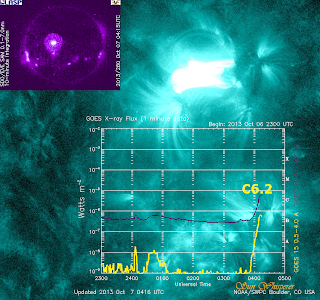Sunday, January 25, 2015
Friday, April 18, 2014
M 7.3 Solar Flare and CME
M7.3-CLASS SOLAR FLARE/CME: Sunspot AR-2036
erupted today, April 18th, at 13:03 UT, producing a strong M7-class
solar flare. NASA's Solar Dynamics Observatory recorded the extreme
ultraviolet flash and eruption in the AIA 304. An S1-class radiation
storm is underway in the aftermath of the flare. However, this is a
relatively minor storm which poses minimal threat to satellites and
aircraft. Of greater interest is a CME that emerged from the blast site.
The Solar and Heliospheric Observatory recorded the storm cloud racing
away from the sun at aproximately 800 km/s. This CME could deliver a
glancing blow to Earth's magnetic field on or about April 20th. Two or
three minor CMEs are expected to preceed this on April 18th-19th, and
the combined impacts could generate a geomagnetic storm during the
weekend. High-latitude sky watchers should be alert for auroras.
Wednesday, April 2, 2014
Sunday, October 6, 2013
C6.2 X Ray Flare 10/07/2013 06:15UTC
Earth facing C6.2 X-ray solar flare erupted from region 1856. 10/07/2013 at about 04:15!the C stands for Common although above C5 is not so common lately.
Thursday, September 12, 2013
New Frontier Reached!
NASA Spacecraft Embarks on Historic Journey into Interstellar Space
NASA's Voyager 1 spacecraft officially is the first human-made object to venture into interstellar space. The 36-year-old probe is about 12 billion miles (19 billion kilometers) from our sun.
New and unexpected data indicate Voyager 1 has been traveling for about one year through plasma, or ionized gas, present in the space between stars. Voyager is in a transitional region immediately outside the solar bubble, where some effects from our sun are still evident. A report on the analysis of this new data, an effort led by Don Gurnett and the plasma wave science team at the University of Iowa, Iowa City, is published in Thursday's edition of the journal Science.
"Now that we have new, key data, we believe this is mankind's historic leap into interstellar space," said Ed Stone, Voyager project scientist based at the California Institute of Technology, Pasadena. "The Voyager team needed time to analyze those observations and make sense of them. But we can now answer the question we've all been asking -- 'Are we there yet?' Yes, we are."
Voyager 1 first detected the increased pressure of interstellar space on the heliosphere, the bubble of charged particles surrounding the sun that reaches far beyond the outer planets, in 2004.
Monday, September 9, 2013
Friday, September 6, 2013
August 2013 Solar Wind & Space Weather From STEREO Ahead & Behind HI1
Looking back at August, 2013 From this big picture view of HI1 you can see solar wind makes it all the way to earth. That other planet that glides by in the beginning is Mercury.
Subscribe to:
Comments (Atom)





